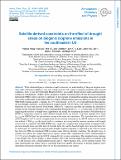Por favor, use este identificador para citar o enlazar a este item:
http://hdl.handle.net/10261/285025COMPARTIR / EXPORTAR:
 SHARE SHARE
 CORE
BASE CORE
BASE
|
|
| Visualizar otros formatos: MARC | Dublin Core | RDF | ORE | MODS | METS | DIDL | DATACITE | |

| Título: | Satellite-derived constraints on the effect of drought stress on biogenic isoprene emissions in the southeastern US |
Autor: | Wang, Yuxuan; Lin, Nan; Li, Wei; Guenther, Alex; Lam, Joey C.Y.; Tai, Amos P.K.; Potosnak, Mark J.; Seco, Roger CSIC ORCID | Palabras clave: | Biogenic isoprene emissions Satellite-derived constraints |
Fecha de publicación: | 7-nov-2022 | Editor: | European Geosciences Union | Citación: | Atmospheric Chemistry and Physics 22: 14189–14208 (2022) | Resumen: | While substantial progress has been made to improve our understanding of biogenic isoprene emissions under unstressed conditions, large uncertainties remain with respect to isoprene emissions under stressed conditions. Here, we use the US Drought Monitor (USDM) as a weekly drought severity index and tropospheric columns of formaldehyde (HCHO), the key product of isoprene oxidation, retrieved from the Ozone Monitoring Instrument (OMI) to derive top-down constraints on the response of summertime isoprene emissions to drought stress in the southeastern United States (SE US), a region of high isoprene emissions that is also prone to drought. OMI HCHO column density is found to be 6.7 % (mild drought) to 23.3 % (severe drought) higher than that under non-drought conditions. A global chemical transport model, GEOS-Chem, with version 2.1 of the Model of Emissions of Gases and Aerosols from Nature (MEGAN2.1) emission algorithm can simulate this direction of change, but the simulated increases at the corresponding drought levels are 1.1-1.5 times that of OMI HCHO, suggesting the need for a drought-stress algorithm in the model. By minimizing the model-OMI differences in HCHO to temperature sensitivity under different drought levels, we derived a top-down drought stress factor (γd_OMI) in GEOS-Chem that parameterizes using water stress and temperature. The algorithm led to an 8.6 % (mild drought) to 20.7 % (severe drought) reduction in isoprene emissions in the SE US relative to the simulation without it. With γd_OMI the model predicts a nonlinear increasing trend in isoprene emissions with drought severity that is consistent with OMI HCHO and a single site's isoprene flux measurements. Compared with a previous drought stress algorithm derived from the latter, the satellite-based drought stress factor performs better with respect to capturing the regional-scale drought-isoprene responses, as indicated by the near-zero mean bias between OMI and simulated HCHO columns under different drought conditions. The drought stress algorithm also reduces the model's high bias in organic aerosol (OA) simulations by 6.60 % (mild drought) to 11.71 % (severe drought) over the SE US compared to the no-stress simulation. The simulated ozone response to the drought stress factor displays a spatial disparity due to the isoprene-suppressing effect on oxidants, with an <1 ppb increase in O3 in high-isoprene regions and a 1-3 ppbv decrease in O3 in low-isoprene regions. This study demonstrates the unique value of exploiting long-term satellite observations to develop empirical stress algorithms on biogenic emissions where in situ flux measurements are limited. | Versión del editor: | https://doi.org/10.5194/acp-22-14189-2022 | URI: | http://hdl.handle.net/10261/285025 | DOI: | 10.5194/acp-22-14189-2022 | ISSN: | 16807316 |
| Aparece en las colecciones: | (IDAEA) Artículos |
Ficheros en este ítem:
| Fichero | Descripción | Tamaño | Formato | |
|---|---|---|---|---|
| acp-22-14189-2022.pdf | Artículo principal | 17,25 MB | Adobe PDF |  Visualizar/Abrir |
| acp-22-14189-2022-supplement.pdf | Material suplementario | 3,16 MB | Adobe PDF |  Visualizar/Abrir |
CORE Recommender
SCOPUSTM
Citations
4
checked on 10-may-2024
WEB OF SCIENCETM
Citations
3
checked on 28-feb-2024
Page view(s)
19
checked on 18-may-2024
Download(s)
24
checked on 18-may-2024
Google ScholarTM
Check
Altmetric
Altmetric
NOTA: Los ítems de Digital.CSIC están protegidos por copyright, con todos los derechos reservados, a menos que se indique lo contrario.
